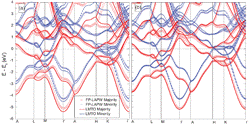Department of Physics and Astronomy: Publications and Other Research
Date of this Version
2014
Document Type
Article
Citation
PHYSICAL REVIEW B 89, 174408 (2014)
Abstract
According to earlier first-principles calculations, the spin-disorder contribution to the resistivity of rare-earth metals in the paramagnetic state is strongly underestimated if Matthiessen’s rule is assumed to hold. To understand this discrepancy, the resistivity of paramagnetic Fe and Gd is evaluated by taking into account both spin and phonon disorder. Calculations are performed using the supercell approach within the linear muffin-tin orbital method. Phonon disorder is modeled by introducing random displacements of the atomic nuclei, and the results are compared with the case of fictitious Anderson disorder. In both cases, the resistivity shows a nonlinear dependence on the square of the disorder potential, which is interpreted as a resistivity saturation effect. This effect is much stronger in Gd than in Fe. The nonlinearity makes the phonon and spin-disorder contributions to the resistivity nonadditive, and the standard procedure of extracting the spin-disorder resistivity by extrapolation from high temperatures becomes ambiguous. An “apparent” spin-disorder resistivity obtained through such extrapolation is in much better agreement with experiment compared to the results obtained by considering only spin disorder. By analyzing the spectral function of the paramagnetic Gd in the presence of Anderson disorder, the resistivity saturation is explained by the collapse of a large area of the Fermi surface due to the disorder-induced mixing between the electron and hole sheets.


Comments
©2014 American Physical Society